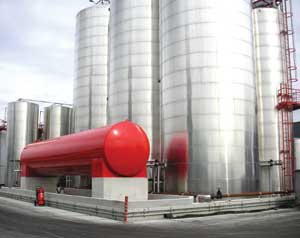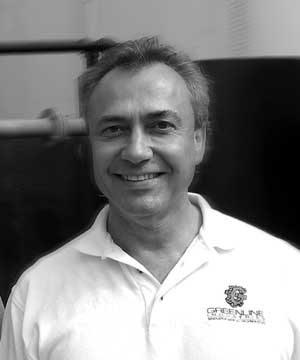Waterless Washing Machine



April 25, 2007
BY Nicholas Zeman
The competition to develop feasible processes that produce high-quality biodiesel is fierce. Dozens of companies are looking to license their proprietary technology to ambitious developers around the world. As the industry continues to grow, it has attracted interest from many different sectors of the industrial world, including chemical manufacturing firms like Rohm and Haas.
The international specialty chemical maker has developed a biodiesel purification system that can reduce a plant's power and water usage. Marketed through San Rafael, Calif.-based Greenline Industries, Rohm and Haas' Amberlite BDIODRY technology is a simple ion exchange purification process that minimizes biodiesel losses and facilitates methanol recovery. Greenline's process design is the first in the industry to use ion resin technology for washing biodiesel, which was the basis for the partnership between Rohm and Haas, and Greenline Industries. "We sought out a partner to provide us with a waterless solution for washing biodiesel," Greenline Industries Cofounder and Vice President of technical development Jacques Sinoncelli says. "We found one in Rohm and Haas."
Rohm and Haas, with annual sales revenue of more than $8 billion, has a portfolio that includes producing chemicals for everything from paints and ceramics to laundry detergent and hair care products. The company has been developing resin technologies for more than 60 years and was able to leverage this knowledge to create a waterless process design for the biodiesel industry. "We have a wide range of technologies and a depth of experience in polymers, so we are excited to apply it to biodiesel, which is very hot right now," says Mark Vandersall technical manager for Philadelphia-based Rohm and Haas. "We've been able to hook up with Greenline to get this technology to the marketplace." Amberlite BD10DRY is composed of polymeric beads, which contains functional groups that can purify, separate or enrich substances from the treated liquid-biodiesel. In other words, the active ion material on the Amberlite attracts the unwanted material in the biodiesel.
Greenline has 27 biodiesel plants under contract, including Patriot Biofuels in Stuttgart, Ark., and Global Alternative Fuels LLC in El Paso, Texas. The 23 plants Greenline sold in 2006, all using the Rohm and Haas Waterless Ion Resin system, represent over 190 million gallons of capacity, the company states. "We're excited to have this technology being installed all around the world," says Jon Fedders of Rohm and Haas.
A Lighter Load
Greenline and Rohm and Haas aren't just interested in building new plants. The companies are armed with a myriad of services to integrate their process into existing facilities, as well. "We offer a retrofit for plants that might want to convert to a waterless system," Sinoncelli says. The system offers technical and economic advantages over other wash or purification methods by lightening the load for distillation, he says. Distillation is often used as a means to purify biodiesel, as well as recover methanol at the back end of a plant. The use of ion resin instead of a water wash does intercede in taking away the largest amount of the fuel that needs to be cooked. In addition, distillation is the most power-intensive aspect of biodiesel production and subsequently the most costly. "If you can alleviate the load, you lessen the cost," Sinoncelli says. "Of course, you still need distillation for methanol recovery."
The Amberlite system operates much like coffee brewing. The crude biodiesel runs over the polymeric beads, which contain chemical groups designed to remove soaps, excess glycerol and other impurities, thus "washing" the fuel so that it will meet even the most stringent international standards. The biodiesel fuel enters the percolator and trickles down through the cylinder of Amberlite. A chemical reaction then renders the unwanted materials neutral, and they cling to Amberlite's beads as the pure fuel exits the cylinder.
An ion resin purification system decreases the amount of water that's used but doesn't eliminate it. It should be noted that even if a facility uses a dry procedure to wash the fuel, it still needs water for the cooling tower, and it needs makeup water, which is pumped through the system during "utility blowdowns" to prevent the accumulation of minerals in the equipment. In addition, every biodiesel plant needs water to run its boilers. Water quality also affects usage. The harder the water in a particular area, the more a biodiesel plant will probably need to flush through its system.
While a biodiesel plant uses less water than an ethanol plant, it's still an issue, especially during the permitting stages. "Greenline saves you the time and the hassle of not having to explain to municipalities or agricultural producers in the area that you would have to use 4 million to 5 million gallons of water from their supply," Sinoncelli says. "In addition, you have much lower operating costs and no water treatment plant."
For producers who might be interested in converting their operations, Rohm and Haas will evaluate the technical and economic advantages of implementing the ion-exchange technology. "This is one of the ways that Greenline benefits from its partnership with Rohm and Haas," Greenline CEO Ted Lavoie says.
Implementing this technology is not a major undertaking, Sinoncelli says. The process has a small footprint and can easily be integrated into any standard biodiesel production process. A feed pipe for the stream that needs to be purified, a column and a pipe to remove the finished fuel is all the equipment that's needed to convert to the Amberlite system. "A column configuration is the most common mode of application for these types of resins," Vandersall says. "The simplicity of the system makes Amberlite easily incorporated into an existing plant." In addition, Greenline says it has eliminated the need for centrifuges, which require a significant amount of maintenance. "We have one of the most reliable plant designs out there," Sinoncelli says. "Our plants have backups on every system."
Amberlite needs to be replaced at regular intervals after the catalyst has been lost, but that can be done without having to shut down the process, Sinoncelli says. Amberlite should be replaced at the rate of about a one metric ton for every 300,000 gallons of biodiesel processed. Once its lifespan is over, it is neutral and nontoxic. "There are different ways to dispose of the resins, and we are looking at ways to use it as a Btu fuel source," Vandersall says. "The spent resin can be used to fire asphalt or cement kilns." Rohm and Haas has an entire research program focused on developing new applications for the spent resin. "We have the opportunity to benefit from Rohm and Haas' research and development excellence," Lavoie says. "We consider Rohm and Haas to be one of our leveraging partnerships that allow us to bring some of the most efficient and innovative solutions to the biodiesel marketplace."
Nicholas Zeman is a Biodiesel Magazine staff writer. Reach him at nzeman@bbibiofuels.com or (701) 746-8385.
The international specialty chemical maker has developed a biodiesel purification system that can reduce a plant's power and water usage. Marketed through San Rafael, Calif.-based Greenline Industries, Rohm and Haas' Amberlite BDIODRY technology is a simple ion exchange purification process that minimizes biodiesel losses and facilitates methanol recovery. Greenline's process design is the first in the industry to use ion resin technology for washing biodiesel, which was the basis for the partnership between Rohm and Haas, and Greenline Industries. "We sought out a partner to provide us with a waterless solution for washing biodiesel," Greenline Industries Cofounder and Vice President of technical development Jacques Sinoncelli says. "We found one in Rohm and Haas."
Rohm and Haas, with annual sales revenue of more than $8 billion, has a portfolio that includes producing chemicals for everything from paints and ceramics to laundry detergent and hair care products. The company has been developing resin technologies for more than 60 years and was able to leverage this knowledge to create a waterless process design for the biodiesel industry. "We have a wide range of technologies and a depth of experience in polymers, so we are excited to apply it to biodiesel, which is very hot right now," says Mark Vandersall technical manager for Philadelphia-based Rohm and Haas. "We've been able to hook up with Greenline to get this technology to the marketplace." Amberlite BD10DRY is composed of polymeric beads, which contains functional groups that can purify, separate or enrich substances from the treated liquid-biodiesel. In other words, the active ion material on the Amberlite attracts the unwanted material in the biodiesel.
Greenline has 27 biodiesel plants under contract, including Patriot Biofuels in Stuttgart, Ark., and Global Alternative Fuels LLC in El Paso, Texas. The 23 plants Greenline sold in 2006, all using the Rohm and Haas Waterless Ion Resin system, represent over 190 million gallons of capacity, the company states. "We're excited to have this technology being installed all around the world," says Jon Fedders of Rohm and Haas.
A Lighter Load
Greenline and Rohm and Haas aren't just interested in building new plants. The companies are armed with a myriad of services to integrate their process into existing facilities, as well. "We offer a retrofit for plants that might want to convert to a waterless system," Sinoncelli says. The system offers technical and economic advantages over other wash or purification methods by lightening the load for distillation, he says. Distillation is often used as a means to purify biodiesel, as well as recover methanol at the back end of a plant. The use of ion resin instead of a water wash does intercede in taking away the largest amount of the fuel that needs to be cooked. In addition, distillation is the most power-intensive aspect of biodiesel production and subsequently the most costly. "If you can alleviate the load, you lessen the cost," Sinoncelli says. "Of course, you still need distillation for methanol recovery."
The Amberlite system operates much like coffee brewing. The crude biodiesel runs over the polymeric beads, which contain chemical groups designed to remove soaps, excess glycerol and other impurities, thus "washing" the fuel so that it will meet even the most stringent international standards. The biodiesel fuel enters the percolator and trickles down through the cylinder of Amberlite. A chemical reaction then renders the unwanted materials neutral, and they cling to Amberlite's beads as the pure fuel exits the cylinder.
An ion resin purification system decreases the amount of water that's used but doesn't eliminate it. It should be noted that even if a facility uses a dry procedure to wash the fuel, it still needs water for the cooling tower, and it needs makeup water, which is pumped through the system during "utility blowdowns" to prevent the accumulation of minerals in the equipment. In addition, every biodiesel plant needs water to run its boilers. Water quality also affects usage. The harder the water in a particular area, the more a biodiesel plant will probably need to flush through its system.
While a biodiesel plant uses less water than an ethanol plant, it's still an issue, especially during the permitting stages. "Greenline saves you the time and the hassle of not having to explain to municipalities or agricultural producers in the area that you would have to use 4 million to 5 million gallons of water from their supply," Sinoncelli says. "In addition, you have much lower operating costs and no water treatment plant."
For producers who might be interested in converting their operations, Rohm and Haas will evaluate the technical and economic advantages of implementing the ion-exchange technology. "This is one of the ways that Greenline benefits from its partnership with Rohm and Haas," Greenline CEO Ted Lavoie says.
Implementing this technology is not a major undertaking, Sinoncelli says. The process has a small footprint and can easily be integrated into any standard biodiesel production process. A feed pipe for the stream that needs to be purified, a column and a pipe to remove the finished fuel is all the equipment that's needed to convert to the Amberlite system. "A column configuration is the most common mode of application for these types of resins," Vandersall says. "The simplicity of the system makes Amberlite easily incorporated into an existing plant." In addition, Greenline says it has eliminated the need for centrifuges, which require a significant amount of maintenance. "We have one of the most reliable plant designs out there," Sinoncelli says. "Our plants have backups on every system."
Amberlite needs to be replaced at regular intervals after the catalyst has been lost, but that can be done without having to shut down the process, Sinoncelli says. Amberlite should be replaced at the rate of about a one metric ton for every 300,000 gallons of biodiesel processed. Once its lifespan is over, it is neutral and nontoxic. "There are different ways to dispose of the resins, and we are looking at ways to use it as a Btu fuel source," Vandersall says. "The spent resin can be used to fire asphalt or cement kilns." Rohm and Haas has an entire research program focused on developing new applications for the spent resin. "We have the opportunity to benefit from Rohm and Haas' research and development excellence," Lavoie says. "We consider Rohm and Haas to be one of our leveraging partnerships that allow us to bring some of the most efficient and innovative solutions to the biodiesel marketplace."
Nicholas Zeman is a Biodiesel Magazine staff writer. Reach him at nzeman@bbibiofuels.com or (701) 746-8385.
Advertisement
Advertisement
Advertisement
Advertisement
Upcoming Events





